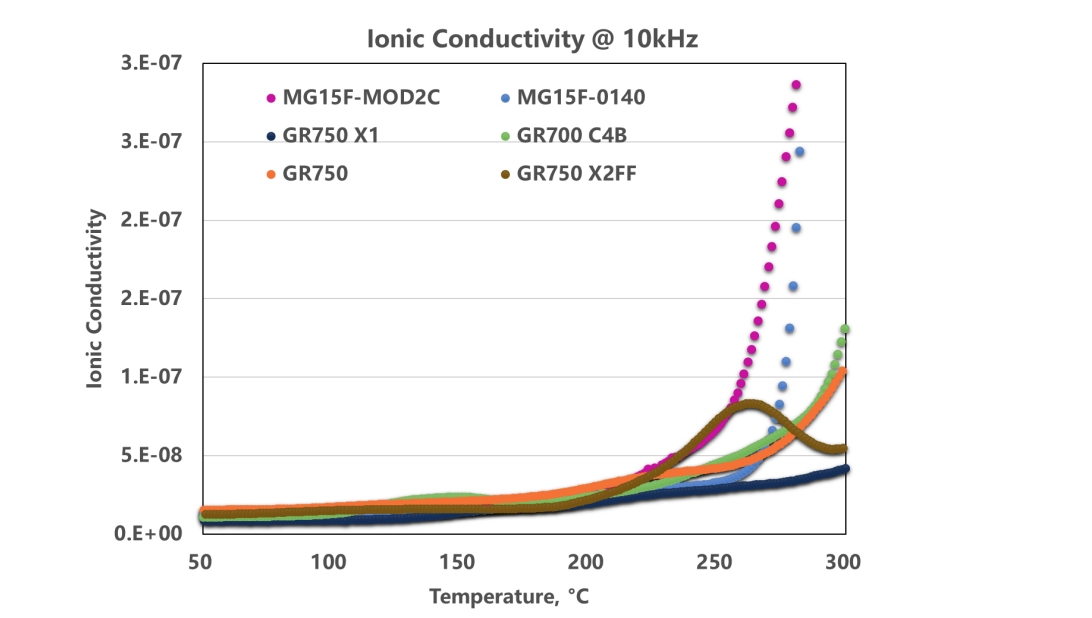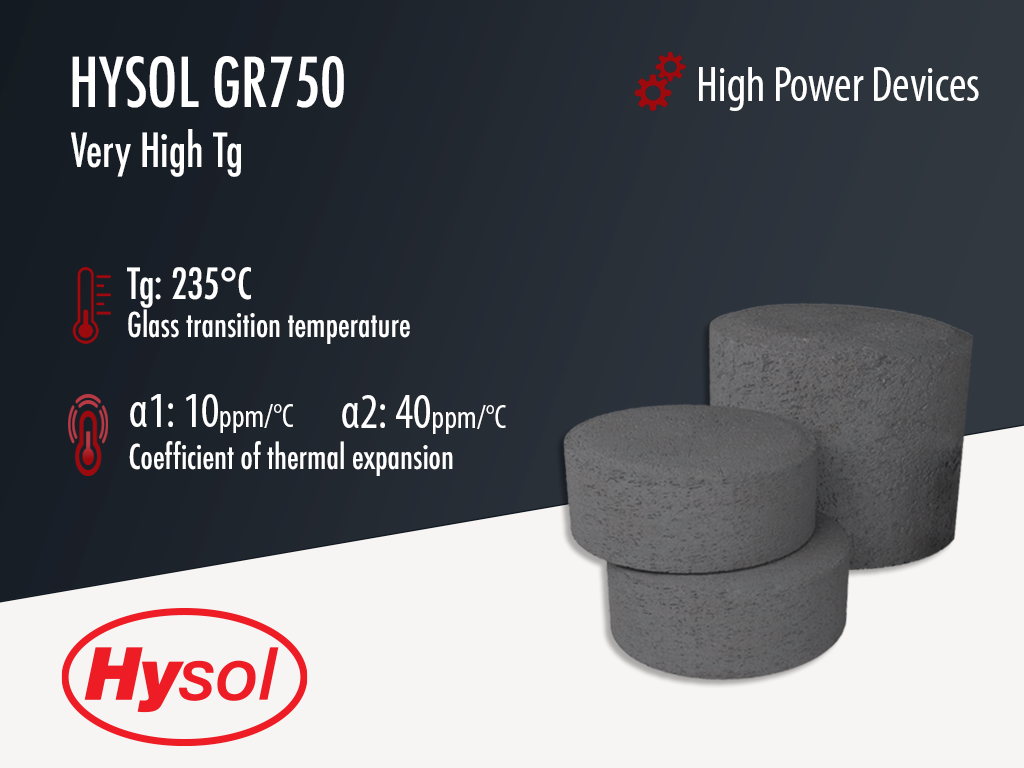Hysol GR750 | Black Epoxy Mold Compound
- For SiC, GaN semiconductors
- Very High Tg: 235°C
- Excellent adhesion to Nickel (Ni) leadframes
Product Description
Hysol GR750 is a halogen free, black, silica filled (75um cut size) semiconductor grade epoxy molding compound. It offers an extremely high Tg (235°C) along with low moisture absorption, low viscosity and excellent adhesion to Nickel (Ni) leadframes, only to be beaten by GR750 X1 (194N tab pull). The GR750 product series has been developed with 3rd generation semiconductors in mind and is the product of choice for Silicon Carbide (SiC) and Gallium Nitride (GaN) packages.
Hysol GR750 is a technologically advanced green epoxy molding compound with excellent electrical performance, designed for high power devices especially for high temperature application with low moisture absorption requirements. It delivers outstanding performance and ease of use. It meets UL 94 V-0 flammability at 1/8 inch thickness.
Available Versions:
Technical Specifications
| General Properties | |||||||
| Color Color The color | Black | ||||||
| Physical Properties | |||||||
| Spiral Flow @ 175°C | 106 cm | ||||||
| Chemical Properties | |||||||
| |||||||
| Moisture absorption | 0.35 % | ||||||
| Mechanical Properties | |||||||
| |||||||
| |||||||
| |||||||
| |||||||
| Electrical Properties | |||||||
| Volume Resistivity Volume Resistivity Volume resistivity, also called volume resistance, bulk resistance or bulk resistivity is a thickness dependent measurement of the resistivity of a material perpendicular to the plane of the surface. | 3.3x1016 Ohms⋅cm | ||||||
| Thermal Properties | |||||||
| |||||||
| |||||||
| Glass Transition Temperature (Tg) Glass Transition Temperature (Tg) The glass transition temperature for organic adhesives is a temperature region where the polymers change from glassy and brittle to soft and rubbery. Increasing the temperature further continues the softening process as the viscosity drops too. Temperatures between the glass transition temperature and below the decomposition point of the adhesive are the best region for bonding. The glass-transition temperature Tg of a material characterizes the range of temperatures over which this glass transition occurs. | 235 °C | ||||||
| UL 94 Rating UL 94 Rating Flammability rating classification. It determines how fast a material burns or extinguishes once it is ignited. HB: slow burning on a horizontal specimen; burning rate less than 76 mm/min for thickness less than 3 mm or burning stops before 100 mm V-2: burning stops within 30 seconds on a vertical specimen; drips of flaming particles are allowed. V-1: burning stops within 30 seconds on a vertical specimen; drips of particles allowed as long as they are not inflamed. V-0: burning stops within 10 seconds on a vertical specimen; drips of particles allowed as long as they are not inflamed. 5VB: burning stops within 60 seconds on a vertical specimen; no drips allowed; plaque specimens may develop a hole. 5VA: burning stops within 60 seconds on a vertical specimen; no drips allowed; plaque specimens may not develop a hole | V0 | ||||||
| Curing Conditions | |||||||
| |||||||
Additional Information
GR750 EMC for High Power & Voltage SiC Devices
Product Comparison Table
Product Name | MG15F-MOD2 | MG15F-0140 | GR750 (Std) | GR750 X1 (Std) | GR750X1 | GR720X2 (Std) | GR750 X2FF | GR720X2 (high CTE) | ||
|---|---|---|---|---|---|---|---|---|---|---|
Epoxy type | - | OCN/BisA/DCPD | OCN/BisA | MFN | MFN/L.W.A. | MFN/L.W.A. | MFN/L.W.A. | MAR | MAR/L.Vis. | |
Hardener type | - | Anhydride | Anhydride | New | New | New | New | New | New | |
Filler cut size | µm | 106 | 150 | 75 | 75 | 75 | 75 | 45 | 75 | |
Flammability | UL-94 | V-0 at ¼” | V-0 at 1/8'' | V-0 at 1/8'' | V-0 at 1/8'' | V-0 at 1/8'' | V-0 at 1/8'' | V-0 at 1/8'' | V-0 at 1/8'' | |
Spiral Flow | inches | 36 | 20 | 42 | 36 | 26 | 45 | 40 | 41 | |
Gel Time | sec | 32 | 17 | 26 | 24 | 29 | 30 | 30 | 35 | |
Viscosity @ 175°C | PaS | 20 | 28 | 10 | 13 | 43 | 25 | 20 | 15 | |
Tg by TMA | oC | 242 | 195 | 225 | 202 | 197 | 170 | 182 | 170 | |
CTE 1 | ppm/°C | 16 | 21 | 10 | 8 | 6 | 9 | 9 | 14 | |
CTE 2 | ppm/°C | 49 | 70 | 40 | 42 | 31 | 35 | 32 | 40 | |
DMA Storage Modulus at RT | MPa | 18246 | 14078 | 20560 | 23155 | 29241 | 21631 | 23391 | 20971 | |
DMA Storage Modulus at 260C | MPa | 6491 | 1883 | 1658 | 1713 | 1711 | 907 | 1007 | 961 | |
Tg by DMA Tanδ Peak | 0C | 270 | 217 | 235 | 207 | 200 | 177 | 182 | 177 | |
Flexural modulus | Mpa | 16312 | 12449 | 16880 | 18042 | 21469 | 17470 | 17549 | 16900 | |
Flexural strength | Mpa | 120 | 126 | 138 | 136 | 134 | 152 | 169 | 150 | |
Moisture absorption PCT24h | % | 0.55 | 0.65 | 0.35 | 0.3 | 0.2 | 0.2 | 0.2 | 0.2 | |
Cl-/ Na+ | ppm | <10 | <10 | <15 | <15 | <15 | <15 | <15 | <15 | |
PH |
| 4~6 | 4~6 | 5~7 | 5~7 | 5~7 | 5~7 | 5~7 | 5~7 | |
Volume resistivity @21C & 500V | Ω.cm | 2.4E+16 | 6.3E+16 | 3.3E+16 | 1.7E+16 | 1.0E+16 | 1.6E+16 | 1.8E+16 | 1.0E+16 | |
Dielectric constant, 21 C & 1MHz |
| 3.6 | 3.7 | 3.7 | 3.7 | 3.7 | 3.8 | 3.8 | 3.9 | |
Adhesion (tabpull) after MSL3 | on Cu | N | 344 | 136 | 365 | 406 | 307 | 360 | 407 | 331 |
on Ag | N | 235 | NA | 345 | 363 | 269 | 234 | 348 | 415 | |
on Ni | N | 84 | 111 | 170 | 194 | 130 | 104 | 102 | 110 | |
Comparative Tracking Index | V | 600 | 400 | 600 | 600 | 600 | 600 | 600 | 600 | |
Recommended Molding condition | 190°C110s | 180°C100s | 180°C 90s | 180°C 90s | 180°C 90s | 180°C 90s | 180°C 90s | 180°C 90s | ||
Recommended PMC condition | 190°C 3~6hrs | 190°C 3~6hrs | 190°C10hrs | 190°C10hrs | 190°C10hrs | 190°C10hrs | 190°C10hrs | 190°C10hrs | ||

DETA Data for the GR7XX product line
DMA and TMA curves of GR750 (Standard)




